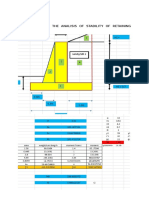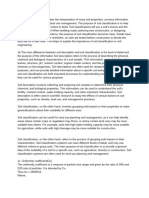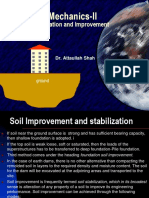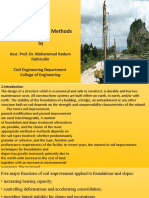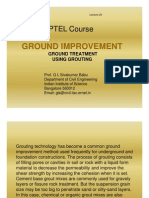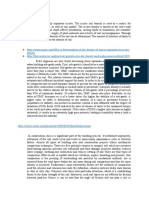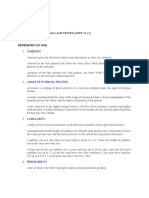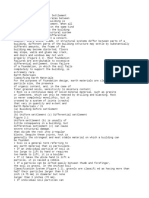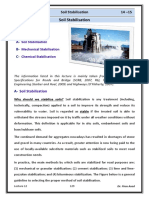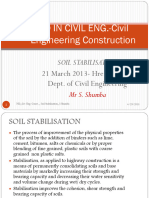Void Ratio e Porosity N Degree of Saturation S Moisture Content
Void Ratio e Porosity N Degree of Saturation S Moisture Content
Uploaded by
Vincent Kwong Jye LoongCopyright:
Available Formats
Void Ratio e Porosity N Degree of Saturation S Moisture Content
Void Ratio e Porosity N Degree of Saturation S Moisture Content
Uploaded by
Vincent Kwong Jye LoongOriginal Title
Copyright
Available Formats
Share this document
Did you find this document useful?
Is this content inappropriate?
Copyright:
Available Formats
Void Ratio e Porosity N Degree of Saturation S Moisture Content
Void Ratio e Porosity N Degree of Saturation S Moisture Content
Uploaded by
Vincent Kwong Jye LoongCopyright:
Available Formats
1. void ratio (e) is defined as the ratio of the volume of voids to the volume of solids. 2.
Porosity (n) is defined as the ratio of the volume of voids to the total volume. 3. The degree of saturation (S) is defined as the ratio of the volume of water to the volume of voids. 4. Moisture content (w) is also referred to as water content and is defined as the ratio of the weight of water to the weight of solids in a given volume of soil. 5. Unit weight (g) is the weight of soil per unit volume.
Sieve analysis consists of shaking the soil sample through a set of sieves that have progressively smaller openings. Sieves are made by weaving two sets of wires at right angles to one another. The square holes thus formed between the wires provide the limit which determines the size of the particles retained on a particular sieve
The hydrometer method depends upon variations in the density of a soil suspension contained in a 1000 mL graduated cylinder. Thedensity of the suspension is measured with a hydrometer at determined time intervals; then the coarsest diameter of particles in suspension at a given time and the percentage of particles finer than that coarsest (suspended) diameter are computed based on Stokes' formula.
Comparison Between AASHTO and USCS Both soil classification systems, AASHTO and Unified, are based on the texture and plasticity of soil. Also, both systems divide the soils into two major categories, coarse grained and fine grained, as separated by the No. 200 sieve. According to the AASHTO system, a soil is considered fine grained when more than 35% passes through the No. 200 sieve. According to the Unified system, a soil is considered fine grained when more than 50% passes through the No. 200 sieve. A coarse-grained soil that has about 35% fine grains will behave like a fine-grained material. This is because enough fine grains exist to fill the voids between the coarse grains and hold them apart. In this respect, the AASHTO system appears to be more appropriate. In the AASHTO system, the No. 10 sieve is used to separate gravel from sand; in the Unified system, the No. 4 sieve is used. From the viewpoint of soil-separated size limits, the No. 10 sieve is the more accepted upper limit for sand. This limit is used in concrete and highway basecourse technology. In the Unified system, the gravelly and sandy soils clearly are separated; in the AASHTO system, they are not. The A-2 group, in particular, contains a large variety of soils. Symbols like GW, SM, CH, and others that are used in the Unified system are more descriptive of the soil properties than the A symbols used in the AASHTO system. The classification of organic soils, such as OL, OH, and Pt, is provided in the Unified system. Under the AASHTO system, there is no place for organic soils. Peats usually have a high moisture content, low specific gravity of soil solids, and low unit weight. The AASHTO classification system is used mostly by state and county highway departments. Geotechnical engineers generally prefer the Unified system.
COMPACTION FOR DEEPER LAYERS OF SOIL
Three types of dynamic compaction for deeper layers of soil are discussed here. They are: 1. Vibroflotation. 2. Dropping of a heavy weight. 3. Blasting.
1. PRELOADING
Preloading is a technique that can successfully be used to densify soft to very soft cohesive soils/. 2. Sand Drains Vertical and horizontal and drains are normally used for consolidating very soft clay, silt and other compressible materials
3. Wick (Prefabricated Vertical) Drains
SOIL STABILIZATION BY THE USE OF ADMIXTURES
The physical properties of soils can often economically be improved by the use of admixtures. Some of the more idely used admixtures include lime, portland cement and asphalt. The process of soil stabilization first involves mixing with the soil a suitable additive which changes its property and then compacting the admixture suitably. This method is applicable only for soils in shallow foundations or the base courses of roads, airfield pavements, etc.
Soil-lime Stabilization Lime stabilization improves the strength, stiffness and durability of fine grained materials. In addition, lime is sometimes used to improve the properties of the fine grained fraction of granular soils. Lime has been used as a stabilizer for soils in the base courses of pavement systems, under concrete foundations, on embankment slopes and canal linings. Adding lime to soils produces a maximum density under a higher optimum moisture content than in the untreated soil. Moreover, lime produces a decrease in plasticity index. Lime stabilization has been extensively used to decrease swelling potential and swelling pressures in clays. Ordinarily the strength of wet clay is improved when a proper amount of lime is added. The improvement in strength is partly due to the decrease in plastic properties of the clay and partly to the pozzolanic reaction of lime with soil, which produces a cemented material that increases in strength with time. Lime-treated soils, in general, have greater strength and a higher modulus of elasticity than untreated soils. Recommended percentages of lime for soil stabilization vary from 2 to 10 percent. For coarse soils such as clayey gravels, sandy soils with less than 50 per cent silt-clay fraction, the per cent of lime varies from 2 to 5, whereas for soils with more than 50 percent silt-clay fraction, the percent of lime lies between 5 and 10. Lime is also used with fly ash. The fly ash may vary from 10 to 20 percent, and the percent of lime may lie between 3 and 7. Soil-Cement Stabilization Soil-cement is the reaction product of an intimate mixture of pulverized soil and measured amounts of portland cement and water, compacted to high density. As the cement hydrates, the mixture becomes a hard, durable structural material. Hardened soil-cement has the capacity to bridge over local weak points in a subgrade. When properly made, it does not soften when exposed to wetting and drying, or freezing and thawing cycles. Portland cement and soil mixed at the proper moisture content has been used increasingly in recent years to stabilize soils in special situations. Probably the main use has been to build stabilized bases under concrete pavements for highways and airfields. Soil cement mixtures are also used to provide wave protection on earth dams. SOIL STABILIZATION BY INJECTION OF SUITABLE GROUTS Grouting is a process whereby fluid like materials, either in suspension, or solution form, are injected into the subsurface soil or rock. The purpose of injecting a grout may be any one or more of the following: 1. To decrease permeability. 2. To increase shear strength. 3. To decrease compressibility. Suspension-type grouts include soil, cement, lime, asphalt emulsion, etc., while the solution type grouts include a wide variety of chemicals. Grouting proves especially effective in the following cases: 1. When the foundation has to be constructed below the ground water table. The deeper the foundation, the longer the time needed for construction, and therefore, the more benefit gained from grouting as compared with dewatering.
2. When there is difficult access to the foundation level. This is very often the case in city work, in tunnel shafts, sewers, and subway construction. 3. When the geometric dimensions of the foundation are complicated and involves many boundaries and contact zones. 4. When the adjacent structures require that the soil of the foundation strata should not be excavated (extension of existing foundations into deeper layers).
You might also like
- Assignment Top Sheet Department of Civil Engineering & TechnologyDocument6 pagesAssignment Top Sheet Department of Civil Engineering & TechnologyEngr MahwishNo ratings yet
- Final Project ReportDocument57 pagesFinal Project ReportGautam NarendraNo ratings yet
- Retaining Wall Design and Soil Improvement MethodDocument17 pagesRetaining Wall Design and Soil Improvement MethodAngelaDeviNo ratings yet
- Soil Properties and Their Influence On Design of DamsDocument15 pagesSoil Properties and Their Influence On Design of DamsHanniel Madramootoo100% (1)
- Unit 17Document12 pagesUnit 17swaraj deshpande123No ratings yet
- Chapter 10 - Foundation Soil ImprovementDocument7 pagesChapter 10 - Foundation Soil Improvementkuchhal014No ratings yet
- Soil StabilizationDocument15 pagesSoil StabilizationFekadu Wub100% (2)
- Construction TechnologyDocument9 pagesConstruction TechnologyAparnaNo ratings yet
- CH 3 Soil Analysis of The ResultsDocument5 pagesCH 3 Soil Analysis of The ResultsAung Kaung MyatNo ratings yet
- Soils AssignmentDocument6 pagesSoils AssignmentndawipaidaNo ratings yet
- Soil Mechanics-II: Soil Stabilization and ImprovementDocument16 pagesSoil Mechanics-II: Soil Stabilization and ImprovementShivpreet SharmaNo ratings yet
- Soil StabilizationDocument5 pagesSoil StabilizationEKWUE ChukwudaluNo ratings yet
- Soil Improvement Methods: Prepared byDocument17 pagesSoil Improvement Methods: Prepared bymedo elmayNo ratings yet
- Soilstabilisation1 151228083503Document92 pagesSoilstabilisation1 151228083503Carmel Buniel SabadoNo ratings yet
- Method of Soil StabilizationDocument29 pagesMethod of Soil StabilizationAbhi WanwadeNo ratings yet
- Soilstabilisation1 151228083503 PDFDocument92 pagesSoilstabilisation1 151228083503 PDFabhayNo ratings yet
- Git NotesDocument19 pagesGit NotesZahid0% (1)
- CVLE464-Lectures 19Document28 pagesCVLE464-Lectures 19omarnajimNo ratings yet
- Group Members: Jehan Jore Mayet Relampagos Mary Mae Alquizar Ernesto SandiganDocument25 pagesGroup Members: Jehan Jore Mayet Relampagos Mary Mae Alquizar Ernesto SandiganMayeterisk RNo ratings yet
- Chapter-1: 1.1 Soil ImprovementDocument28 pagesChapter-1: 1.1 Soil ImprovementNischal LgNo ratings yet
- Compaction Seminar ReportDocument32 pagesCompaction Seminar Reportdaddakoli007100% (2)
- Chapter 2.5 MORTARDocument9 pagesChapter 2.5 MORTARMikiasNo ratings yet
- Bituminous Soil Stabilization AssignmentDocument5 pagesBituminous Soil Stabilization AssignmentScott MuthuriNo ratings yet
- Presentation Permeation Grouting Prof - Dr. HanifiDocument31 pagesPresentation Permeation Grouting Prof - Dr. HanifiChalakAhmedNo ratings yet
- Hybrid BricksDocument24 pagesHybrid Bricksrajmohanroy50% (2)
- Compaction of Subgrade SoilsDocument28 pagesCompaction of Subgrade SoilsSaeed KhawamNo ratings yet
- ch-10 Ground Improvement TechniqueDocument14 pagesch-10 Ground Improvement TechniqueRJ JordanNo ratings yet
- Types of Grouting PDFDocument24 pagesTypes of Grouting PDFSurender Singh83% (6)
- Questionnaire and Conclusion Sand ReplacementDocument2 pagesQuestionnaire and Conclusion Sand ReplacementMuhammad Firdaus AzraiNo ratings yet
- Compaction of Soil - Definition, Principle and EffectDocument16 pagesCompaction of Soil - Definition, Principle and EffectafafaaaNo ratings yet
- Stabilization of Soil Using AdmixtureDocument17 pagesStabilization of Soil Using AdmixtureVarun Singh ChandelNo ratings yet
- Chapter 6 - Bearing Capacity of SoilDocument14 pagesChapter 6 - Bearing Capacity of SoilSaurav Shrestha100% (1)
- What Is Ground ImprovementDocument5 pagesWhat Is Ground ImprovementDipankar HazarikaNo ratings yet
- CVE 131 - CompactionDocument109 pagesCVE 131 - CompactionZxeroNo ratings yet
- Guiniling, Jojie D. Bsce-2Cns Construction Materials and Testing (MWF 10-12)Document9 pagesGuiniling, Jojie D. Bsce-2Cns Construction Materials and Testing (MWF 10-12)guinilingjojieNo ratings yet
- 1 UnitDocument13 pages1 UnitSubbulakshmiNo ratings yet
- NICMAR GPQS-11 - Construction TechnologyDocument11 pagesNICMAR GPQS-11 - Construction TechnologyshajbabyNo ratings yet
- Use of Waste Plastic in Road ConstructionDocument33 pagesUse of Waste Plastic in Road ConstructionShruti SinghalNo ratings yet
- Surface CompactionDocument7 pagesSurface CompactionEftikarNo ratings yet
- Fundation MaterialDocument9 pagesFundation MaterialBertin BakariNo ratings yet
- Stabilised Mud BlockDocument42 pagesStabilised Mud BlockAmrutha Sivaraman0% (1)
- Plaster TestsDocument23 pagesPlaster TestsRobin SNo ratings yet
- Compaction Seminar ReportDocument32 pagesCompaction Seminar ReportKhalid Bin Walid100% (1)
- What Are The Different Investigation Methods Carried Out Before Grouting?Document17 pagesWhat Are The Different Investigation Methods Carried Out Before Grouting?himabindugvsd71No ratings yet
- Soil DensityDocument5 pagesSoil DensityRoberto AlvitresNo ratings yet
- SoilDocument2 pagesSoilAbdul WasayNo ratings yet
- Joshua Stanley Myombo FinalDocument35 pagesJoshua Stanley Myombo FinalChris Joseph100% (1)
- Soil ImprovementDocument60 pagesSoil Improvementahmd.elgouhryNo ratings yet
- Geotechnical Engineering Notes 333Document40 pagesGeotechnical Engineering Notes 333TinaNo ratings yet
- (Refer PPT For Graphs & Figures) : Cement StabilizationDocument17 pages(Refer PPT For Graphs & Figures) : Cement StabilizationJaisuryaNo ratings yet
- 1Document21 pages1yugank942No ratings yet
- Grouting On Sandy SoilDocument48 pagesGrouting On Sandy SoilSabari PrasanthNo ratings yet
- Lec 12 Highway Engineering - Soil StabilisationDocument8 pagesLec 12 Highway Engineering - Soil StabilisationDr Firas Asad100% (1)
- Sand ReplacementDocument4 pagesSand ReplacementHidayah MuzaimilNo ratings yet
- 3.1) Soil Compaction - Methods, Tests and EffectDocument18 pages3.1) Soil Compaction - Methods, Tests and EffectJoseph AsfourNo ratings yet
- Soil Mechanics-E4 (Questions)Document2 pagesSoil Mechanics-E4 (Questions)Siti Munirah Binti ZainudinNo ratings yet
- Lesson 2. Soil Formation - BDocument8 pagesLesson 2. Soil Formation - BJessie Jade Sestina Duroja - MainNo ratings yet
- Soil StabilizationDocument5 pagesSoil StabilizationMarzhan Kabdrakhman100% (1)
- ND Cec Soil Stabilisation Cec 2013Document26 pagesND Cec Soil Stabilisation Cec 2013Tatenda PaduzeNo ratings yet


